How To Set Up Survival Fishing Limb Lines.
In this article we will cover how to set up survival fishing limb lines.
We also cover what is a limb line and give multiple examples with pictures of the different set ups, as well as the positive and negatives of each one.
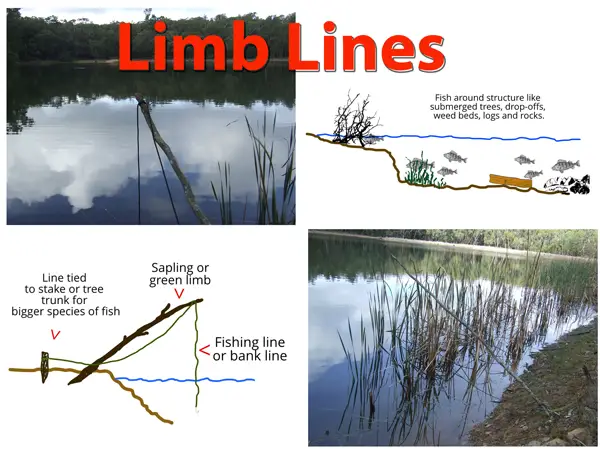
What is a limb line?
The limb line is a springy pole or limb with fishing line attached and a hook.
It can be a flexible green stick, or a young sapling, like a fishing rod. Or even a tree limb overhanging close to the water line can work for a limb line.
For survival fishing, limb lines are another bushcraft tool that can be worth learning in a survival situation.
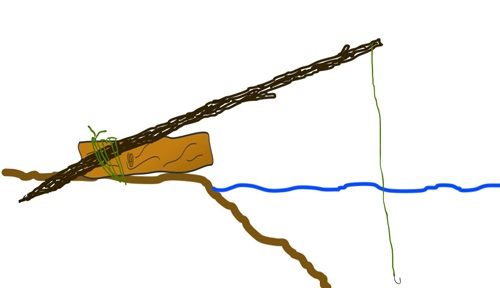
Limb lines, or springers as they are called in some countries, can be fashioned up quickly and driven into the ground, tied to a tree, or even using a tree branch. When the fish bites, the pole or sapling, ideally should be springy enough (Hence the name springer.) to set the hook and hold the fish.
What are the positives of the limb line fishing?
The advantage of a limb line is that they can be left overnight or during the day to fish passively. Meaning less energy and time is used once set up, rather than actively fishing. Ideal for bushcraft and survival as you can utilize your time on other projects.
Another benefit of this fishing technique, is that you can set up several lines out.
The more limb line sets put out, the better. With three, six, or a dozen or more lines out, will obviously improve your chances for catching fish.
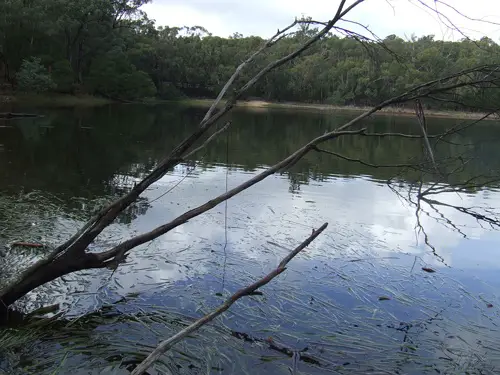
What are the negatives of the limb line?
Setting up two limb lines, might take the same time and energy as setting up a gill net or a fishing trotline.
As an example, the trotline could have six hooks, twenty hooks or even more on one line. (See my article on methods and set ups of the Survival Fishing Trotlines.) To set up a trotline, you basically need two anchor points. Which roughly takes the same amount of time to set up two limb lines, which would only have two hooks.
So the limb line can be less efficient in that regard compared to some other survival fishing tools.
How do you set up a fishing limb line?
There are numerous ways to set up the rig. From different ways of securing the pole, to using natural roots or overhanging limbs as the fishing pole.
Here are a few ways on how to set up the survival fishing limb line.
Basic limb line rig.
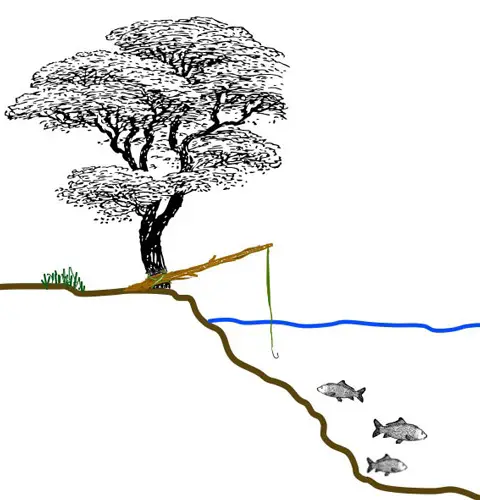
The basic limb line pole can be dug / staked into the ground or tied to a tree.
The spring pole has to be long enough, to put the line out far enough into the water, so the structure holding the pole should be sturdy. A “Y” stake in the ground can be added to support it, or a log in front of it.
Extra anchor point.
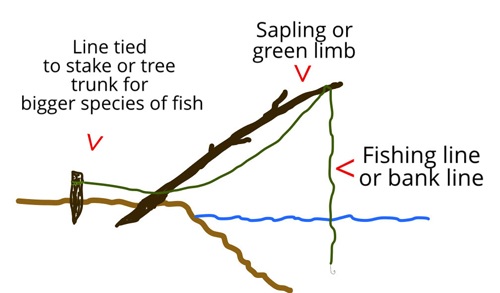
If there are big fish species in the water, or the pole you are using may not be strong as you like, tie the end of the line to a secondary anchor point. So you would have the line tied to the end of the pole as normal, but also continue it back on land to another anchor point. Like to the butt of the pole, tree trunk or an extra stake into the ground.
If you know the waters contain only small fish then a secondary tie of point may not be necessary. Or if you don’t have enough resources. (Fishing Line.)
Limb line tied to tree branch.
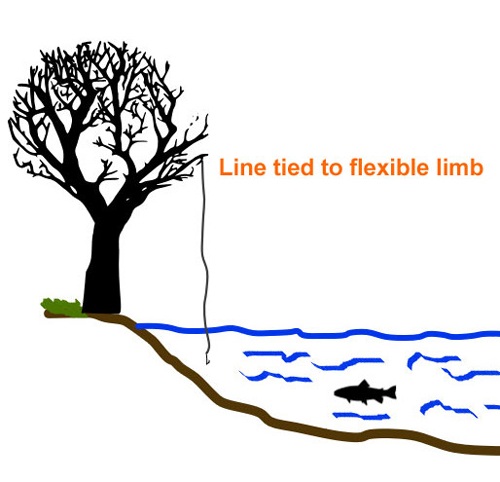
Branches overhanging low to the water can make easy limb lines. Make sure the limb is springy and not rotten. If the limb is not solid and you can also tie the line additionally to the tree.
Shrubs and trees like willows, normally have a good amount of branches drooping over close to the water. They also provide shelter and shade for the fish. Insects living in these trees can also be blown off the tree into the water, also attracting fish to the area.
Limb line tied to tree root undercut.
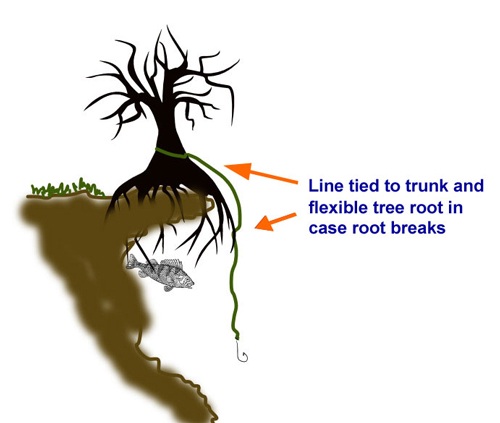
An advantage of tying the line to roots or an undercut banks is, the fish have a natural habitat and generally feel safe from predators, so might already be living there.
One drawback is finding a springy or strong enough tree root that isn’t rotted. Also trying to getting access to the tree root to tie it on, may not be easy. Be careful with deep waters and the undercut ground, as it may collapse underneath.
A secondary tied point might also be used for flimsy tree roots.
Limb line tied to submerged tree or branch.
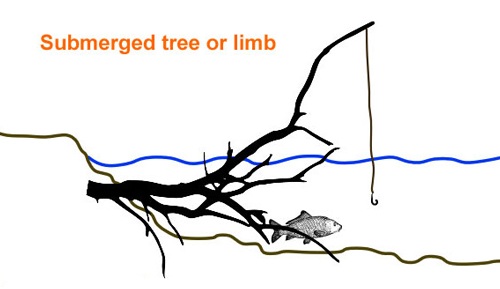
This can be an effective set up, as you have a natural structure that fish may be hiding around.
One disadvantage of using submerged tree roots or tree limbs sticking out of the water is that the wood can be rotting and not as strong or have minimal spring in the limb. Hence less chance of setting the hook, or the limb breaking off for a stronger fish.
Another disadvantage is getting to the limb, climbing out on the fallen tree trunk or slippery submerged limb might be dangerous in cold or fast moving waters.
Limb line with no land or trees close to the water.
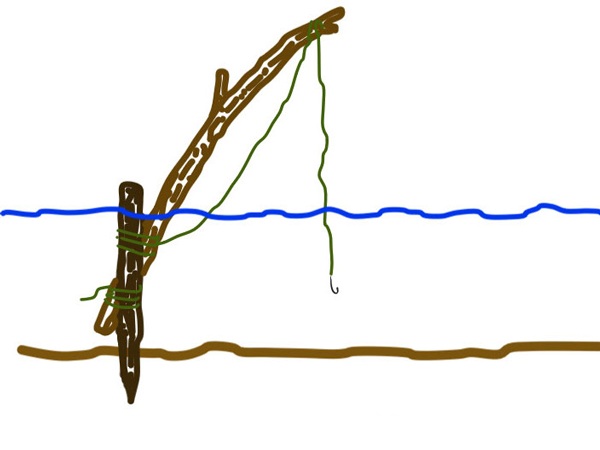
Shallow open waters, marsh areas, flood plains or even saltwater areas may present a fishing opportunity, even if there are no land or trees to secure a limb line.
A long steak is driven into the ground or sand, in the shallow water and the spring pole tied to the stake can work. Or the pole could be wedged between rocks in the water.
Be aware of high tides, which may completely drown the rig. Or for low tide you may presenting the bait on dry land and not in the water.
Limb line with spring pole and L7 trigger.
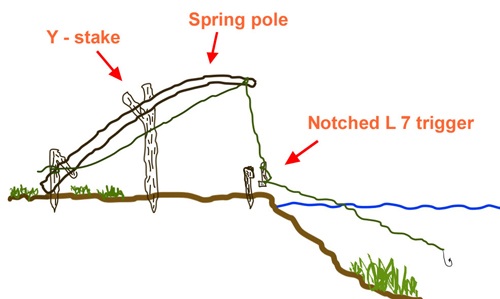
A spring snare type trigger, like the L7 trigger can also be used for a fishing limb line. The trigger system can automatically set the hook and hopefully catch the fish.
Sensitivity of the trigger is also something to consider. Wind and smaller fish can set off the trigger if it is too sensitive. If the trigger it is too unresponsive, it is harder for the fish to set it off.
Also experiment with the angle of the line connecting to the spring L7 trigger stake. It may work better on an angle out from the pole. (If the line is directly above the L7, the spring pole may just pull up and be harder to set off.) The angle of the stake can also be used to adjust the sensitivity of it.
Continue the line in one piece when throughout, when tied to the “L” section for a stronger rig. (Rather than the line being in two separate pieces tied on the “L”.)
The negatives of the L7 trigger fish trap is it takes time to set up one. An option could be set up several normal limb lines, (Without triggers.) then if you have some down time, modify the ones you have in the water, one by one. Or add more poles. This way you have lines in the water passively fishing, rather than wasting time trying to get one L7 fish pole set up and the trigger sensitivity just right.
(Shawn Kelly from Corporals Corner has a good YouTube video on the Automatic Fishing Pole and David Canterbury from The Pathfinder School, has a fishing video on the L7 Trigger System.)
Speed hooks and Yo Yo automatic survival fishing reels are getting more popular and might be worth looking at. (I haven’t tried them yet and not sure how reliable, heavy or bulky they are, but they look interesting.)
The limb line pole.
A young green sapling roughly from about five feet (About 1.5 m.) to about ten feet (Around 3 m.) will work. This will depend on the size of fish and resources about.
A green springy flexible pole will be more robust and suitable then a dead old limb, which could be rotting or snap if bent.
Pole diameter will depend on the timber around and fish size. Are the species of fish, bait-fish size, pan size, bragging photo size or we are going to need a bigger boat size fish? The diameter might range from little finger size, to wrist size. For bigger fish, wrist or even arm thicker may be required.
Ideally a tapering pole will give you a bit more spring at the tip and strength at the butt or end of the pole.
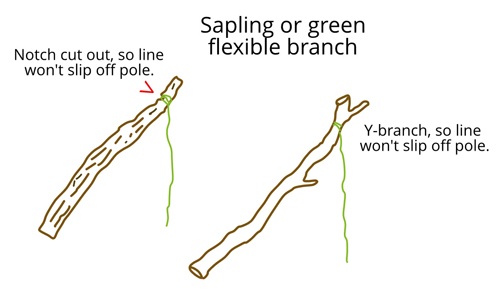
So the fishing line won’t slip of the pole, cut a small groove or notch on the pole tip. Alternatively use a branch that has a “Y” tip.
Ranger bands for shock absorbers and set the hook.
If the fishing poles aren’t springy enough, a ranger band can be used to help set the hook.
The ranger band also helps absorb some shock of the fish biting and puts less stress on the pole, line, hook, etc.
As well as the initial fish strike, the bands also help when the fish is fighting on the line for a long time. This is especially handy for taking stress of the fishing rig for bigger fish.
Make sure you tie the ranger band into a continuous piece of fishing line or mariner’s bank line. If you use two pieces of fishing line tied to each end of the ranger bands, the band may break and you lose the fish and line.
(My father used the rubber tire bands with limb lines to good effect, to help catch large fish up to 80 lb.) (36 kg.)
Fishing bait.
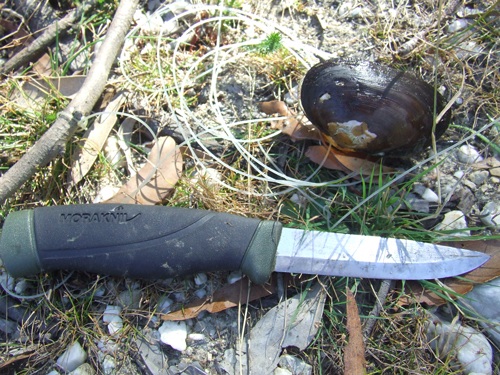
Natural bait like, worms, larvae, beetles, grasshoppers, snails, frogs, crawfish (Crayfish, yabbies.) shrimp, maggots, baitfish etc., can be used.
Some bigger fish have even been known to eat mice, lizards and small birds. Left over bits of meat and of course fish guts can also be used as bait.
If bait is hard to come by, artificial flies and lures can be made with natural and man-made materials.
A strip of paracord sheath, inner cord, feathers, silver foil, fur, hair, strips of bandana, pieces of potato chip packets, etc. can be improvised for a lure. Windy days, making the water choppy, waves or river currents and tides, can put some movement / action into the lure. This can help entice a fish to bite.
For murky waters, baits with smell will help the strike rate. A small piece of worm or natural bait can be used in conjunction with an improvised lure.
Fishing line and poundage.
Paracord, mariner’s bank line, micro cord, hootchie cord or fishing line can be used for the limb lines.
You can also use thicker fishing line or cordage from the sapling and a finer line for the tippet or leader with the terminal end or hook end.
If you have smaller fish or a particular fussy species, thinner line may present the bait more naturally and the fishing line harder to spot for the fish. Although it might be a trade-off for strength.
I normally carry around 10lb (4.53 kg) or so line, and around 50 lb (22.67 kg) and some hootchie cord, which is similar to smaller diameter mariner’s bank line. I wrap the lines around a piece of PVC pipe. So with basically 3 strengths of fishing lines, I can fish in a variety of waters for a variety of fish species.
(Para cord can also be broken down to smaller strands.)
Fishing line poundage will be a personal choice and will depend on you waters and fish species around. If you hike the mountains were minor streams and small brook trout are, there is no sense in taking only just 60 lb (27.21 kg) line.
Likewise if you do all your bushcraft or camping close to the sea, just packing 6 lb (2.72 kg) fishing line may not be sensible for the bigger fish species.
Natural cordage for fishing line can be made from plant fibers and bark, etc., but can be time consuming.
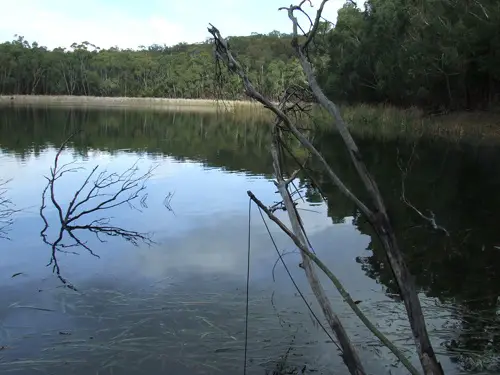
Sinkers or fishing weights.
For some fish, sinkers won’t be necessary, for other fish that will be feeding down close to the bottom, sinkers are crucial.
Fishing weights also help keep the bait down if your bait or line has a tendency to want to float. Also the wind, waves, river flow, etc., can push the line and bait to the water surface level and snag floating debris.
As sinkers are heavy and bulky to carry, improvised sinkers can be made from: Stones, heavy dense wood, shells, bone, rubbish like cans and bottles. (Be careful if the weight is too heavy on the fishing line, the fish may feel the weight of the sinker. Also the bait may not present itself in the water as natural.)
A bandana, mosquito net, article of clothing can also be used as a fishing weight and double as a burley or chum bag. Place fish eggs, mashed up shell fish, fish stomach contents, insects with some weight like pebbles, sand, etc., inside the bag and tie it on for a weight.
(If fishing with several limb lines, place the other lines down current of the chum bag, so the smell can drift down to those fishing lines and entice the fish.)
Rodents and birds can also steal your bait if it is too close to the surface, so fishing weights might be used.
I remember one time fishing my father, our baits were constantly getting stolen from the springers. We thought it was either small fish stealing the bait, or water rats. Which there were plenty of rats around the area. The limb line was placed deeper with a sinker and a trap on the bank set. That done the trick. (I have heard the water rat fur is very buoyant and makes a great fly fishing fly.)
Depending on desired bait depth and fish species targeted and current, you may need fishing weights on the line.
Fishing swivels.
For small fish, swivels may not be required on the limb lines.
But if left overnight, or for larger species, fishing swivels are worth putting on the line. As the bigger fish can easily twist the line and cut it off.
Swivels aren’t bulky and are lightweight, so it might be worth considering putting some in your survival fishing kit.
Fishing hooks.
A smaller hook can catch a bigger fish, but a bigger hook is harder to catch a smaller fish. However the trade-off is the smaller hooks are not as strong. Quality hooks will make a difference for bigger fish though.
If the bait is constantly being stolen but no hooks ups, try a smaller size hook.
Circle hooks are highly regarded in some fishing groups and some fisherman say they increase the catch rate.
Have a few different hook sizes in your fishing survival kit, that suit the areas your mainly go.
If no hooks are available, gorge hooks can also be fashioned and used.
For survival situations, hooks can also be used to help catch birds, reptiles and rodents.
Floats.
If fishing over weed beds, or you want the bait high in the water’s surface, a fishing float might be useful. (It can also be used as a visual strike indicator.) While you can certainly make the leader shorter, a float can give movement to the bait.
Floats, while light weight in the survival fishing kit can be bulky to carry. Here are some improvised floats, both natural and man-made: Used plastic or glass water bottles, corks, pool noodles, balloons, foam rubbish, bamboo, leaves, driftwood can be good improvised floats. Animal stomach can also be fashioned into a balloon type float.
The plastic bottle may be filled with a little bit of water or dirt and the weight helps throw the line out.
One downside of fishing floats, is that it can be blown back to shore if the wind is in the wrong direction. Depending on the length of fishing line and pole, floats may need supervision, which loses the benefits of passive fishing with the limb line.
Fishing wire trace leaders.
Wire trace for leaders are useful for fish with sharp teeth, spines or gill rakers, which can cut the fishing line easily.
Wire trace leaders are also suited to leave longer between checking the rigs, but they are bulkier and heavier to hike around. However, the wire trace might be able to double up for animal snares and traps well.
If you target fish species in areas were the fish are likely to cut your line, wire traces might be invaluable.
Where to fish.
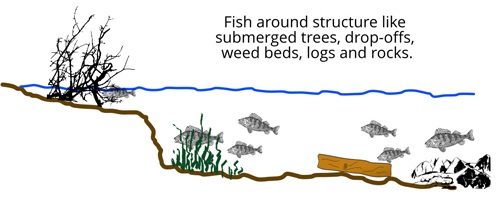
Ideally fish and place limb lines around natural and man-made structures like, weed beds, submerged timber, drop-offs, rocks, outlets, inflows, piers, channels, reefs, undercut and deep holes in the bank, etc.
Depending on fish species, the shallows at night time and newly flooded areas may provide feeding opportunities. (As insects, worms, etc. get caught in the rising water levels.)
Fish have some similar needs to humans in that they like safety, comfort and food. Fishing around structure/s may provide food and shelter needs for the fish, all in one spot.
Comfort levels like the amount of oxygen in the water, sediment and water temperatures also effect the fishes’ location and feeding pattern.
E.g. In hot weather, trout will try to avoid too warmer water and go deeper in the cooler thermoclines or shaded locations. An overhanging tree might provide shade and shelter from birds and might be a good location to bait.
A connecting stream or river providing cooler in-flowing oxygenated water might also be a place to set lines.
Wind direction, (Blowing insects into the water.) protected slow moving water away from fast currents, might also be worth thinking about when placing limb lines.
How often do you check the fishing lines?
Depending on the situation the lines might be checked every few hours, or left overnight and checked first thing in the morning. If the fishing lines are performing well, then check more often before other predators steal the fish, or the fish gets off.
If the baits are being stolen from the hook from smaller fish, try a smaller hook (Or two.) and a more robust bait that will be harder to pull off the hook if possible. Tie the bait on with cotton or thin wire, may also make it harder for the bait to get stolen.
Fishing legalities.
Check local and state laws for the legalities of fishing methods. A lot of limb lines, trotlines and gill nets are illegal in some countries and states. Check your fishing regulations for the equipment and methods allowed.
Risk vs reward.
For survival fishing, you have to also weigh up the energy going to be used, (Calories out.) to put the lines out, for what you are going to get hopefully in return for the catch. (Potential calories in.)
Dangers of survival fishing.
As well as energy used, possible dangers have to be considered when setting up the lines, like: falling into icy cold water, rising flash flooding rivers or powerful fast flowing rivers.
Making decisions when you are exhausted or tired around dangerous water, may or may not be sensible in the circumstances.
In some climates, mosquito’s, snakes, crocodiles, alligators, bears, etc. could be a real concern in your area.
Even a small hook in your hand or minor cut, can cause a lot of serious complications, like an infection.
Summary – Survival fishing limb lines.
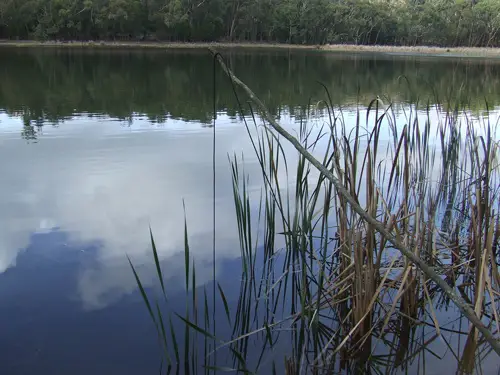
For a survival situation, a gill net or trotline has a lot of advantages around fish-able waterways over a limb line. However, if the resources are limited, or the environment doesn’t suit a trotline, then limb lines are worth setting up.
The benefits of passively fishing with limb lines, (Or trotlines and gill nets.) are once the baits are set, you can save time and perform other bushcraft tasks. All without expending too many calories seeking food.
This time between checking the lines could be used for collecting and processing firewood, building a shelter, collecting and boiling water, setting snares or actively hunting for game.
